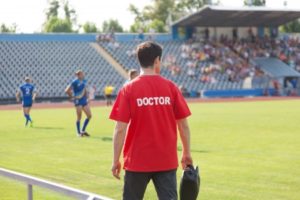 The knee might be the largest joint in the body, but it is also the most vulnerable to injury because of its complex structure. Most knee injuries can be treated with rest, braces or strengthening exercises. However, surgery may be needed when severe injuries occur or when conservative treatment has failed.
The knee might be the largest joint in the body, but it is also the most vulnerable to injury because of its complex structure. Most knee injuries can be treated with rest, braces or strengthening exercises. However, surgery may be needed when severe injuries occur or when conservative treatment has failed.
What is Runner’s Knee?
Do you have aching pain around, behind or in front of your kneecap or hear/feel a popping or grinding sensation in your knee? These are two of the most common symptoms of runner’s knee, also known as patellofemoral pain syndrome (PFPS). Wait…you’re not a runner? It doesn’t matter; it could still be runner’s knee because the term is actually a misnomer. You do not need to be a runner to suffer from this condition and may have it if you have swelling around your knee or experience pain when:
- Bending your knee while walking
- Walking up or down steps or hills
- Squatting or kneeling
- Getting up from a chair
Runner’s knee is actually a broad term used to describe the pain you feel from several different knee conditions, including chondromalacia patella where the cartilage under the kneecap deteriorates. Other reasons that can cause runner’s knee include:
- Direct trauma from a fall or body contact to the knee
- Malalignment of any of the bones from the hip down to the ankle, which prevents the kneecap from moving smoothly
- Overuse from high-stress exercises, such as lunges that irritate the knee
- Weak or unbalanced thigh muscles, including the quadriceps that fail to keep the kneecap in place
- Foot issues, including fallen arches, overpronation or hypermobile feet
How Runner’s Knee is Treated
A sport medicine doctor, such as Dr. Howard Marans are often the best choice to seek treatment for a knee problem. The first treatment your doctor will recommend is the RICE protocol:
- Rest
- Ice
- Compression
- Elevation
RICE and over-the-counter NSAIDs, including naproxen or ibuprofen are often enough to provide relief from your symptoms. Your doctor may recommend exercises to stretch and strengthen your quadriceps muscles or prescribe physical therapy. Orthotics or arch supports may also be recommended to adjust the position of your feet.
Recovery time will vary from patient to patient. You should avoid any physical activity that causes your knee pain until your knee feels as strong as your other knee and the pain has gone away. For instance, instead of running, try swimming, which will not put pressure on your knee.
Why You Should Choose Dr. Howard Marans
When seeking treatment for runner’s knee, you want expert care from a top sports doctor who has been specifically trained in knee issues. Dr. Howard Marans has completed a Knee and Shoulder Fellowship at Toronto’s Orthopedic Arthritic Hospital and has successfully treated thousands of patients over the past twenty years.
If you have knee pain, do not delay treatment. Please call 714.979.8981 or click below to schedule your consultation with Dr. Marans today.












